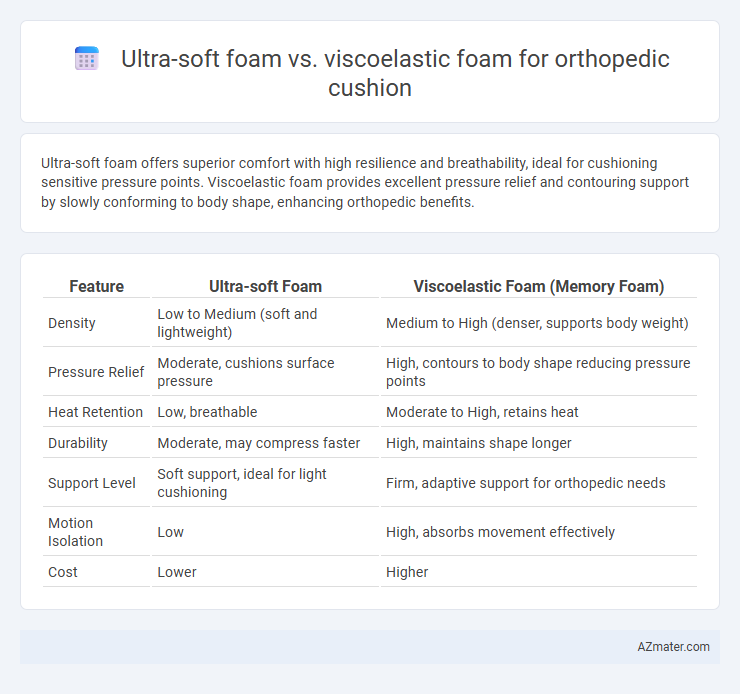Ultra-soft foam offers superior comfort with high resilience and breathability, ideal for cushioning sensitive pressure points. Viscoelastic foam provides excellent pressure relief and contouring support by slowly conforming to body shape, enhancing orthopedic benefits.
Table of Comparison
| Feature | Ultra-soft Foam | Viscoelastic Foam (Memory Foam) |
|---|---|---|
| Density | Low to Medium (soft and lightweight) | Medium to High (denser, supports body weight) |
| Pressure Relief | Moderate, cushions surface pressure | High, contours to body shape reducing pressure points |
| Heat Retention | Low, breathable | Moderate to High, retains heat |
| Durability | Moderate, may compress faster | High, maintains shape longer |
| Support Level | Soft support, ideal for light cushioning | Firm, adaptive support for orthopedic needs |
| Motion Isolation | Low | High, absorbs movement effectively |
| Cost | Lower | Higher |
Introduction to Orthopedic Cushions
Orthopedic cushions are designed to provide targeted support and alleviate pressure points for individuals with musculoskeletal issues or prolonged sitting requirements. Ultra-soft foam offers gentle cushioning with excellent breathability, making it suitable for light pressure relief and comfort. Viscoelastic foam, also known as memory foam, contours closely to body shape, enhancing spinal alignment and distributing weight evenly to reduce pain and improve posture during extended use.
What is Ultra-Soft Foam?
Ultra-soft foam is a highly pliable cushioning material designed to provide immediate comfort and gentle support by evenly distributing body weight and reducing pressure points. Compared to viscoelastic foam, which responds slowly to pressure with a memory effect, ultra-soft foam offers a quicker, more responsive softness ideal for orthopedic cushions targeting sensitive areas. Its open-cell structure enhances breathability and durability, making it suitable for prolonged use in orthopedic applications.
What is Viscoelastic (Memory) Foam?
Viscoelastic foam, also known as memory foam, is a high-density polyurethane material infused with viscoelastic polymers that respond to body heat and pressure, molding to the body's shape for superior support and pressure relief. Unlike ultra-soft foam, which offers immediate cushioning but less contouring, viscoelastic foam evenly distributes weight and reduces pressure points, making it ideal for orthopedic cushions designed to alleviate pain and improve spinal alignment. This foam's slow recovery rate enhances comfort by adapting to postural changes while maintaining durability for long-term orthopedic use.
Key Differences Between Ultra-Soft and Viscoelastic Foams
Ultra-soft foam offers a plush, highly breathable surface that provides immediate comfort and pressure relief ideal for short-term use. Viscoelastic foam, also known as memory foam, reacts to body heat and weight by contouring precisely to anatomical shapes, promoting superior orthopedic support and spinal alignment. Key differences include ultra-soft foam's faster rebound rate and lighter density compared to viscoelastic foam's slower response time and ability to evenly distribute pressure for long-term joint and bone health.
Pressure Relief: Ultra-Soft vs Viscoelastic Foam
Ultra-soft foam provides gentle cushioning with moderate pressure relief suitable for light orthopedic support, but it may compress quickly under body weight, reducing long-term comfort. Viscoelastic foam, known as memory foam, conforms closely to body contours, distributing pressure evenly and significantly reducing pressure points for enhanced orthopedic relief. This superior pressure distribution makes viscoelastic foam ideal for individuals requiring targeted support to prevent pain and improve spinal alignment.
Support and Spinal Alignment Comparison
Ultra-soft foam provides gentle cushioning with minimal resistance, often resulting in less effective support for proper spinal alignment in orthopedic cushions. Viscoelastic foam, also known as memory foam, conforms closely to body contours, offering superior pressure relief and enhanced spinal alignment by evenly distributing weight and reducing pressure points. Studies indicate viscoelastic foam significantly improves ergonomic support, making it a preferred choice for orthopedic cushions targeting spinal health.
Durability and Longevity: Which Foam Lasts Longer?
Ultra-soft foam offers initial comfort but tends to compress and degrade faster under consistent orthopedic use, leading to reduced durability over time. Viscoelastic foam, also known as memory foam, has higher density and resilient cell structure, providing superior longevity and maintaining its supportive properties for extended periods. In orthopedic cushions, viscoelastic foam outperforms ultra-soft foam in sustaining shape and durability, making it the preferred choice for long-term use.
Temperature Regulation and Breathability
Ultra-soft foam offers moderate breathability but often lacks advanced temperature regulation compared to viscoelastic foam, which features temperature-sensitive properties that contour to body heat, enhancing comfort. Viscoelastic foam, also known as memory foam, typically incorporates gel infusions or open-cell structures to improve airflow, significantly reducing heat retention and promoting a cooler sleeping surface. Both foams contribute to pressure relief; however, viscoelastic foam excels in maintaining thermal balance and breathability for extended orthopedic use.
Best Use Cases for Each Foam Type
Ultra-soft foam provides gentle support and is ideal for individuals requiring pressure relief without deep contouring, making it suitable for sensitive skin and light orthopedic needs such as minor joint pain or short-term seating. Viscoelastic foam, commonly known as memory foam, offers superior body contouring and pressure distribution, making it best for chronic conditions like arthritis or spinal alignment issues that require targeted support and prolonged comfort. Each foam type serves distinct orthopedic purposes: ultra-soft foam excels in cushioning and immediate comfort, while viscoelastic foam is optimal for long-term therapeutic support and enhanced pressure management.
Choosing the Right Foam for Orthopedic Cushions
Choosing the right foam for orthopedic cushions involves comparing ultra-soft foam and viscoelastic foam based on support and comfort needs. Ultra-soft foam offers gentle cushioning ideal for pressure relief in sensitive areas, while viscoelastic foam, also known as memory foam, provides superior contouring by molding to body shape and distributing weight evenly. Prioritizing viscoelastic foam enhances spinal alignment and reduces pain, making it a preferred choice for orthopedic applications requiring both durability and therapeutic support.

Infographic: Ultra-soft foam vs Viscoelastic foam for Orthopedic cushion
 azmater.com
azmater.com